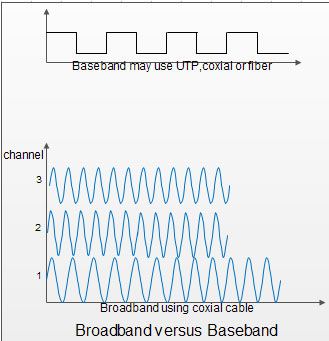Broadband A communications medium that can carry a wide range of signal frequencies, typically from audio up to video frequencies. In telecommunications the significance of a broadband system is that it can carry television and videoconferencing data as well as voice calls. A broadband medium can be made to carry many signals at once by apportioning its total bandwidth into many independent channels, each of which carries only a specific range of frequencies. In contrast, a BASEBAND can carry only a single channel. ATM, ADSL and Cable TV are all broadband media, while standard ISDN barely qualifies.
There exist two LAN transmission options, Baseband and Broadband. Baseband LANs, which is the most prevalent by far, is a Single-channel system that supports a single transmission at any given time.
Broadband LANs, which are most unusual, support multiple transmissions via multiple frequency channels.
We’ll be covering the following topics in this tutorial:
Broadband LANs

Broadband LANs are Multichannel, analog LANs as shown in Figure. typically based on coaxial cable as the transmission medium, although fiber optic cable is also used. Individual channels offer bandwidth of 1 to 5 Mbps, with 20 to 30 channels typically supported. Aggregate bandwidth is as much as 500 MHz. Its characteristics are:
• Digital signal modulated onto RF carrier (analog)
• Channel allocation based on FDM
• Head-End for bidirectional transmission
• Stations connected via RF modems, Le. radio modems accomplish the digital-to-analog conversion process, providing the transmitting device access to an analog channel.
Advantages
Data, voice and video can be accommodated on broadband channel
• Greater distances
• Greater bandwidth.
Disadvantages
• Cable design
• Alignment and maintenance
• High cost, requires modems
• Lack of well-developed standards.
Some broadband LANs are referred to as IOBroadband36 where 10stands for 10Mbps, Broadband for multichannel and 36 for 3600 meters maximum separation between devices.
Baseband LANs
Baseband LAN is single channel, supporting a single communication at a time as shown in Figure. They are digital in nature. Total bandwidth of I to 100Mbps is provided over coaxial cable, UTP, STP, or fiber optic cable. Distance limitations depend on the medium employed and the specifics of the LAN protocol. Baseband LAN physical topologies including ring, bus, tree, and star.
Baseband LANs are by far the most popular and the most highly standardized. Ethernet, Token Passing, Token Ring and FDDI LANs are all baseband. They are intended only for data, as data communications is, after all, the primary reason for the existence of LANs. The characteristics of this system may be summarized as follows:
• Unmodulated digital signal
• Single channel
• Bidirectional propagation of signal
• Stations connected, via T connectors
• No need of modems – low cost installation.
Advantages
• Simplicity
• Low cost
• Ease of installation and maintenance
• High rates.
Disadvantages
• Limited distances
• Data and voice only.
 Dinesh Thakur holds an B.C.A, MCDBA, MCSD certifications. Dinesh authors the hugely popular
Dinesh Thakur holds an B.C.A, MCDBA, MCSD certifications. Dinesh authors the hugely popular